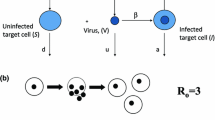Abstract
A class of minimal models is constructed that can exhibit several salient phenomena associated with T-cell inoculations that prevent and cure autoimmune disease. The models consist of differential equations for the magnitude of two populations, the effectorsE (which cause the disease), and an interacting regulator populationR. In these models, normality, vaccination and disease are identified with stable steady-states of the differential equations. Thereby accommodated by the models are a variety of findings such as the induction of vaccination or disease, depending on the size of the effector inoculant. Features such as spontaneous acquisition of disease and spontaneous cure require that the models be expanded to permit slow variation of their coefficients and hence slow shifts in the number of steady-states. Other extensions of the basic models permit them to be relevant to vaccination by killed cells or by antigen, or to the interaction of a larger number of cell types. The discussion includes an indication of how the highly simplified approach taken here can serve as a first step in a modeling program that takes increasing cognizance of relevant aspects of known immunological physiology. Even at its present stage, the theory leads to several suggestions for experiments.
Similar content being viewed by others
Literature
Alborán, M. D., J. C. Gutierrez, J. A. Gonzalo, J. L. Andreu, M. A. R. Marcos, G. Kroemer and C. Martinez-A. 1992. lpr T-cells vaccinate against lupus in MRL/lpr mice.Eur. J. Immunol. 22, 1089–1093.
Av-Ron, E., H. Parnas and L. A. Segel. 1993. A basic biophysical model for bursting neurons.Biol. Cybern. 69, 87–95.
Ben-Nun, A., H. Wekerle and I. R. Cohen. 1981. Vaccination against autoimmune encephalomyelitis with T lymphocyte line cells reactive against myelin basic protein.Nature 292, 60–61.
Beraud, E., O. Lider, E. Baharav, T. Reshef and I. R. Cohen. 1989. Vaccination against experimental autoimmune encephalomyelitis using a subencephalitogenic dose of autoimmune effector cells. I. Characteristics of vaccination.J. Autoimmun. 2, 75–86.
Cohen, I. R. 1986. Regulation of autoimmune disease: physiological and therapeutic.Immunol. Rev. 94, 5–21.
Cohen, I. R. 1988.Perspectives on Autoimmunity. Boca Raton, FL: CRC Press.
Cohen, I. R. and H. Atlan. 1989. Network regulation of autoimmunity: an automaton model.J. Autoimmun. 2, 613–625.
de Boer, R. J., L. A. Segel and A. S. Perelson. 1992. Pattern formation in one-and two-dimensional shape space models of the immune system.J. theor. Biol. 155, 295–333.
Doya, K. and S. Yoshizawa. 1989. Adaptive neural oscillator using continuous-time back-propagation learning.Neural Networks 2, 375–385.
Elias, D., T. Reshef, O. S. Birk, R. van der Zee, M. D. Walker and I. R. Cohen. 1991. Vaccination against autoimmune mouse diabetes with a T-cell epitope of the human 65-kDa heat shock protein.Proc. natn. Acad. Sci. U.S.A. 88, 4577–4580.
Howell, M. D., S. T. Winters, T. Olee, H. C. Powell, D. J. Carlo and S. W. Brostoff. 1989. Vaccination against experimental allergic encephalomyelitis with T-cell receptor peptides.Science 246, 668–670.
Kumar, V. and E. E. Sercarz. 1992. T cell regulatory circuitry: antigen-specific and TCR-idiopeptide-specific T cell interactions in EAE.Int. Rev. Immunol. 9, 269–279.
Kumar, V. and E. E. Sercarz. 1993. TCR-peptide-specific regulatory CD4+ T cells are involved in recovery from antigen-induced autoimmune disease.178, 909–916.
Lider, O., M. Shinitzky and I. R. Cohen. 1986. Vaccination against experimental autoimmune diseases using T lymphocytes treated with hydrostatic pressure.Ann. N. Y. Acad. Sci. 475, 267–273.
Lohse, A. W., T. W. Spahn, T. Wölfel, J. Herkel, I. R. Cohen and K. H. Meyer zum Büschenfelde. 1993. Induction of the anti-ergotypic response.Int. Immunol. 5, 533–539.
Naparstek, Y., A. Ben-Nun, J. Holoshitz, T. Reshef, A. Frenkel, M. Rosenberg and I. R. Cohen. 1983. T lymphocyte lines producing or vaccinating against autoimmune encephalomyelitis (EAE): functional activation induces PNA receptors and accumulation in the brain and thymus of line cells.Eur. J. Immunol. 13, 418–423.
Odell, G., G. Oster, P. Alberch and B. Burnside. 1981. The mechanical basis of morphogenesis. I. Epithelial folding and invagination.Dev. Biol. 85, 446–462.
Offner, H., G. A. Hashim and A. A. Vandenbark. 1991. T-cell receptor peptide therapy triggers autoregulation of experimental encephalomyelitis.Science 251, 430–432.
Raine, C. S. 1984. Biology of disease. Analysis of autoimmune demyelination: its impact upon multiple sclerosis.Lab. Invest. 50, 608–635.
Rauch, J. G. 1993. The law on reverse engineering.IEEE Spectrum 30, 47–48.
Rinzel, J. 1987. A formal classification of bursting mechanisms in excitable systems. InMathematical Topics in Population Biology. Morphogenesis and Neurosciences, E. Teramoto and M. Yamaguti (Eds), Lecture Notes in Biomathematics, Vol. 71, pp. 267–281. Berlin: Springer.
Segel, L. A. and E. Jäger. 1994. T-cell vaccination via reverse engineering: transient disease.Proceedings of the Second European Conference on Mathematics Applied to Biology and Medicine. P. Auger and J. Demongeot (Eds).
Segel, L. A. and M. Slemrod. 1989. The quasi-steady state assumption: a case study in perturbation.SIAM Rev. 31, 446–447.
Segel, L. A., E. Jäger, D. Elias and I. R. Cohen. 1994. A quantitative model of autoimmune disease and T cell vaccination: why more cells may produce less effect. Unpublished.
Wiegand, A. S. and N. A. Gershenfeld (Eds). 1993.Time Series Prediction: Forecasting the Future and Understanding the Past. Reading, MA: Addison-Wesley.
Author information
Authors and Affiliations
Rights and permissions
About this article
Cite this article
Segel, L.A., Jäger, E. Reverse engineering: A model for T-cell vaccination. Bltn Mathcal Biology 56, 687–721 (1994). https://doi.org/10.1007/BF02460717
Received:
Revised:
Issue Date:
DOI: https://doi.org/10.1007/BF02460717




